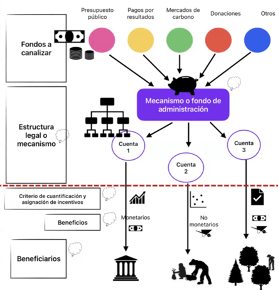Summary of the Eighth Session of the Working Group on Safeguards and Integrity of the UN-REDD Programme in Latin America and the Caribbean, held on 21 November 2024.
Introduction
The eighth session of the Safeguards and Integrity Working Group (SWG) on the framework of the UN-REDD Programme in Latin America and the Caribbean was held on 21 November 2024 and led by the United Nations Environment Programme (UNEP).
This session, which addressed Benefit Sharing Systems (BSS) in the context of REDD+, explored the interaction between BSS and safeguards, to ensure environmental and social sustainability.
BSS are key mechanisms to ensure that resources raised through REDD+ initiatives, whether through voluntary carbon markets or results-based payments, are distributed in an equitable, transparent and efficient manner. Benefits can be monetary, such as financial resources or economic incentives, or non-monetary, such as technical assistance, infrastructure or other support.
The virtual session brought together experts in this field from the public sector, the private sector and international cooperation, who shared their experiences and lessons learned in this field.
Presentations
The session began with a welcome by Judith Walcott, Coordinator of the UN-REDD Team UNEP LAC, who highlighted the strategic relevance of the BSS in the context of REDD+. Judith emphasized that BSSare a key element for the success and sustainability of REDD+ by ensuring a fair distribution of benefits.
In her opening remarks, she said that well-designed BSS have the potential to contribute to ensuring that the benefits derived from REDD+ reach key stakeholders involved in forest protection, including Indigenous Peoples, local communities, women and other priority groups, in a fair and appropriate manner. At the same time, she noted that the BSS face several challenges, including the identification of beneficiaries, the definition of priorities, the alignment with legal frameworks, and the need to ensure effective participation in the design and implementation of the BSS.
In this regard, Walcott stressed that the safeguards approach is fundamental not only to design inclusive and transparent BSS, but also to ensure their effective implementation in practice.
The first presentation was given by Mariano Cirone, senior safeguards expert of the UNEP LAC team. Cirone provided an introduction on BSS highlighting their strategic importance for REDD+ and their potential to consolidate safeguards principles in practice. Mariano explained that the BSS have an essential role to play at several levels. They can strengthen the engagement of those responsible for REDD+ activities; generate concrete and positive impacts for different stakeholders, including Indigenous Peoples and local communities. The also help consolidate effective compliance with key rights and safeguard standards, such as gender equity and inclusive participation, Cirone added.
To describe some aspects of how it works in practice, Cirone presented a general structure of an BSS(Figure 1). He explained that financial resources from various sources - such as public budgets, performance payments and carbon markets - can be channelled into a centralised fund or national mechanism, such as a trust or forest fund. This fund can manage different types of assets and redistribute them through specific "sub-funds" or accounts. For example, one percentage of revenues can be allocated to monitoring systems, another to Indigenous Peoples, and another to sustainable forest management activities. To ensure fair and effective distribution, this process must be governed by clear and transparent rules, with inclusive governance involving technical, financial and civil society actors.

Furthermore, Cirone stressed that the identification of beneficiaries is a crucial step in the design of the BSS. Benefits can be linked to the efforts of different actors to reduce emissions, with an equitable and results-based system. He also mentioned that it is relevant to consider that benefits are not limited to financial incentives but also include elements that strengthen the technical and organizational capacity of the actors involved.
In his concluding remarks, Cirone pointed out that there is wide discretion in the design of BSS, which represents both an opportunity and a challenge. Although specific rules vary according to funding sources, equity and transparency are key criteria to ensure the legitimacy of the systems. Furthermore, he highlighted that safeguards serve as a framework for designing and evaluating BSS, as these systems represent an opportunity to bring the benefits of REDD+ directly to the people and communities who play key roles in protecting forests.
The second presentation was given by María Elena Herrera Ugalde, Director of the Directorate for the Development and Commercialisation of Environmental Services of the Ministry of Environment and Energy of Costa Rica. She focused on Costa Rica's experience in the design and implementation of its own Benefit Sharing System (BDS) in the framework of REDD+. Herrera Ugalde emphasised that a benefit sharing plan must consider fundamental elements such as legality, legitimacy, equality, transparency, efficiency, effectiveness and interculturality. These principles were the basis of the plan developed by Costa Rica for its Emissions Reduction Programme, which included consultation processes with various stakeholders, including private sector players and Indigenous Peoples. In Costa Rica, emission reductions are managed both by the public sector, given that forest resources are the natural heritage of the state, and by the private sector.
Costa Rica's benefit-sharing scheme is structured around four main monetary instruments. First, the Forest Emission Reduction Contract, designed by the government to recognise and reward carbon mitigation. Second, an Inclusive Fund for Sustainable Development, designed to support projects with an impact on vulnerable communities. Third, a plan to strengthen the National System of Conservation Areas (SINAC), focused on addressing the causes of deforestation and forest degradation, as well as developing conservation policies. Finally, a Green Business Fund, aimed at promoting sustainable economic activities for those people or communities that do not own forest areas, but can undertake projects that reduce emissions or contribute to environmental improvement.
In closing, Herrera Ugalde shared several lessons learned from the Costa Rican process. Among them, she underlined the importance of having clear legal and institutional conditions, political support at the highest level and the integration of safeguards as an indispensable component for the development and success of the benefit-sharing plan. These lessons position Costa Rica as a good example for the region in the design of mechanisms that integrate sustainability, inclusion and effectiveness in the management of REDD+ resources.
The session continued with a panel discussion moderated by Cirone, with the participation of Rosa María Martínez and Cynthia Margarita Arévalo Rincón, experts from the World Bank; Bojan Philip Auhagen, from the United Nations Development Programme (UNDP); and the aforementioned Herrera Ugalde from the Government of Costa Rica. The "Talk Show" was a dynamic space in which panelists shared their visions, approaches and learnings on the design and implementation of Benefit Sharing Systems (BDS).
The first question tackled by the panel explored the approaches implemented by their institutions to BDSdesign and implementation, also being asked to share relevant emblematic cases. Arévalo Rincón highlighted the World Bank's pioneering role in carbon markets, noting that the bank currently manages several carbon funds that have helped reduce over 200 million tonnes of emissions in 60 countries. These funds not only seek to reduce emissions, but also to ensure that these carbon credits are of high integrity. Cynthia highlighted that one of these funds, the SPFS, works on large-scale jurisdictional REDD+ programmes and has a mandatory requirement that countries develop a benefit-sharing plan with specific characteristics, which must be disclosed prior to the signing of any emission reduction agreement. This approach ensures transparency and compliance with international standards in benefit sharing.
Auhagen agreed by pointing out that the design of a benefit-sharing plan should focus on the benefit-sharing process itself, conceived as a space for inclusive dialogue. In this process, all stakeholders must come to a shared understanding of what constitutes benefits. According to Auhagen, equity does not necessarily imply that everyone receives the same proportion of the financial benefits, but that all participants have the opportunity to be part of the process and collectively decide how these benefits are distributed. He also stressed the importance of incorporating a safeguards perspective from the design of the plan, ensuring transparency and explaining procedures in a way that is clear and understandable to all stakeholders.
The second question for the panel focused on the challenges related to safeguards when designing and implementing BSS. Herrera Ugalde pointed out that one of the key challenges is land tenure, especially when it is linked to carbon rights or biodiversity. In Costa Rica, not all people own forest areas, which has led the country to develop different inclusive funds that promote participation and give recognition beyond land ownership. This openness allows more actors to benefit from REDD+ initiatives, regardless of their tenure status, and reinforces social and environmental justice in the national context.
Auhagen added that one of the main challenges lies in the operational management of the systems. He stressed the need for actions and commitments related to the SDGs to be implementable in practice. This includes adequate resources, robust operational systems and efficient planning to meet the safeguards set out in the various regulatory and financial frameworks. Without sound operational management, even the most promising designs may face difficulties in implementation.
Arévalo Rincón provided a perspective focused on managing exclusion risks in Benefit Sharing Systems (BDS). She highlighted that the World Bank requires an environmental and social assessment as an initial step, which identifies potential risks that may influence the design of the benefit sharing plan. A concrete example was presented in the case of Guatemala, where the legislation establishes that emission reductions are the responsibility of landowners. However, this framework presents significant challenges, as in some cases Indigenous Peoples do not have formal recognition of their land tenure due to historical conflicts and resettlement.
In response to this challenge, a decree was developed that recognises ancestral titles, allowing tenure to be legally validated and establishing that the implementers of the actions (holders of these areas) are recognised as beneficiaries and owners of the emission reductions generated. This approach not only resolves legal conflicts, but also ensures that Indigenous Peoples are included in benefit sharing.
Arévalo Rincón also pointed out that REDD+ activities can disproportionately benefit large landowners compared to smallholders, which could exacerbate pre-existing inequalities. For this reason, she emphasised the need to design benefit-sharing schemes that include specific mechanisms to ensure inclusiveness. In this context, she highlighted the role of ENABLE, a Multi-Donor Fund created with the objective of expanding access to benefits for the most vulnerable populations. This fund acts as a key resource to address inequities and ensure that REDD+ benefits are distributed equitably, promoting both social justice and the sustainability of the programme.
Open dialogue
During the open dialogue, participants had the opportunity to pose questions to the panellists, which enriched the session with practical experiences and concrete challenges in the design and implementation of BSS.
The first question came from Alicia Albertos, representative of CONAFOR Mexico, who directed her query to Herrera Ugalde from Costa Rica. Albertos asked what was the criteria used to designate the percentage allocated to the women's inclusive fund and whether Herrera Ugalde had faced specific challenges in this allocation. In her response, Herrera Ugalde explained that the first challenge was the creation of the Gender Action Plan of the National REDD+ Strategy, a complex effort where macho societies persist, both at the community and institutional level. She stressed that political support was fundamental to advance in this process, as it allowed institutionalizing gender work and opening spaces for its implementation.
Herrera Ugalde shared that one of the gaps identified in the plan was women's limited ability to access financing from national banks. Many of them did not have bank accounts because on family farms money was traditionally managed by men, which excluded them from accessing credit. This finding prompted the need to structure a gender plan that initially had no budget for its implementation. However, thanks to the arrival of resources from climate finance, it was possible to build specific funds. Subsequently, operational manuals were developed to manage and implement these funds, ensuring that they were accessible and responded to the needs identified in the action plan.
The second question was posed by Nuvia Briceño, representative of CONAF Chile, who addressed Arevalo from the World Bank. Briceño asked for more details on ENABLE, the Multi-Donor Trust Fund, and how countries can access these resources. Arevalo explained that accessing ENABLE requires countries to work directly with the emissions reduction programme manager and the World Bank’s social specialist. Together, they must assess the social and inclusion gaps they wish to address and design a solid proposal to submit to the fund. This process involves not only identifying needs but also establishing a clear strategy to ensure that resources support the most vulnerable populations in an effective and equitable manner.
Closing points
The closing remarks were made by Felipe Guntin from UNEP, who underlined the importance of Benefit Sharing Systems (BSS) in the REDD+ framework. Felipe stressed that designing and implementing a BDS is not simply a technical issue, but an act of strategic responsibility. These systems are fundamental not only to ensure that benefits are distributed fairly, but also to strengthen transparency and equity in REDD+ implementation processes.
Guntin concluded by stressing that the safeguards approach forms the foundation of the entire REDD+ architecture. Safeguards, he noted, have evolved to become a cross-cutting element that permeates all aspects of REDD+ programmes. Without the integrity of safeguards, it would not be possible to build trust, inclusion and respect for fundamental rights – the necessary pillars that ensure the sustainability and legitimacy of these programmes.
The eighth session of the Working Group on Safeguards and Integrity of the UN-REDD Programme in Latin America and the Caribbean, in brief:

participants

countries represented

UN agencies

minutes of Session
About the Working Group
The Safeguards and Integrity Working Group of the UN-REDD Programme in Latin America and the Caribbean is a space made up of staff and experts working on the design, implementation and monitoring of REDD+ safeguards in the region, with the objective of sharing experiences, good practices, common challenges and lessons learned, in order to improve the implementation, monitoring and reporting of safeguards and strengthen the environmental and social integrity of REDD+ in LAC.
For more information about the work, please contact the UNEP team through Mariano Cirone at mariano.cirone@un.org

